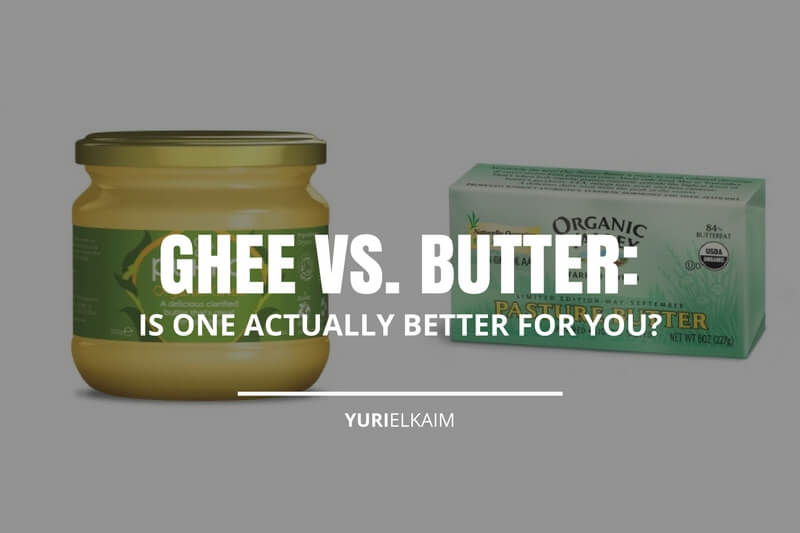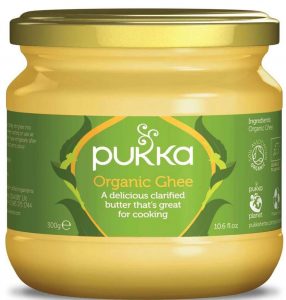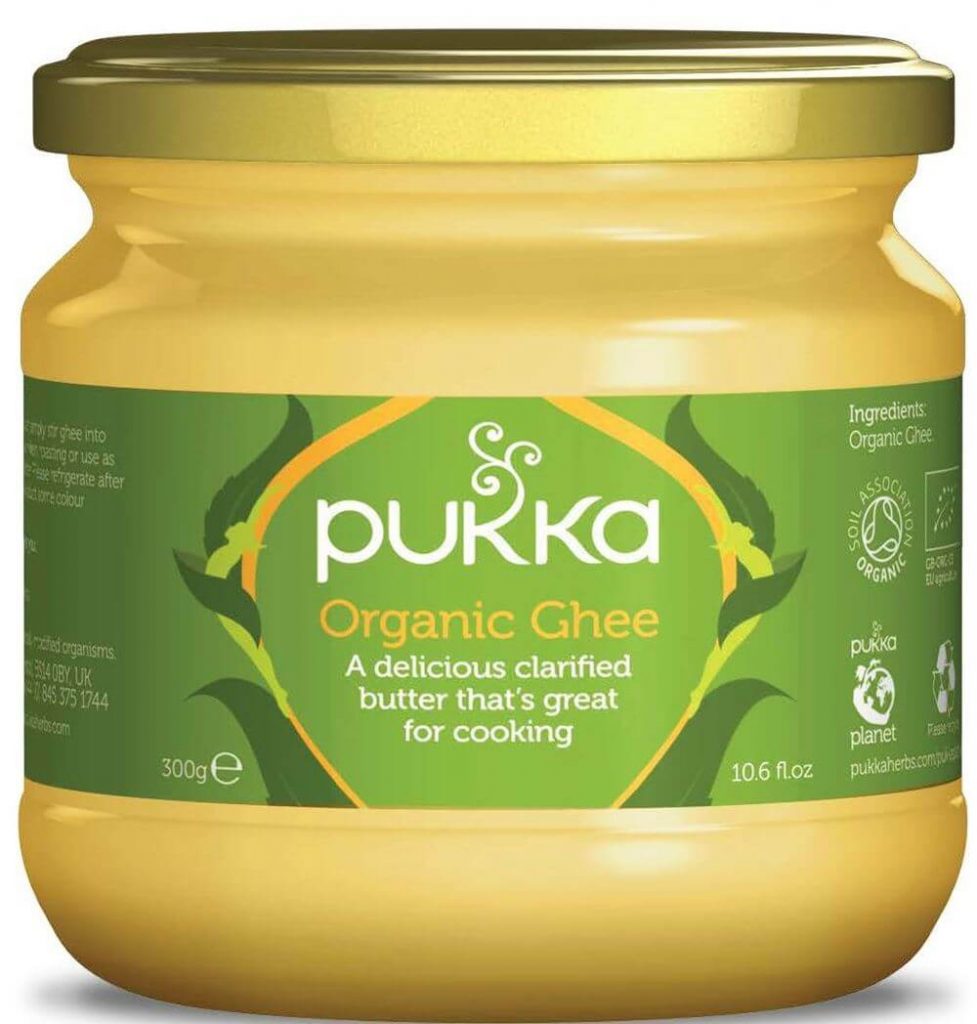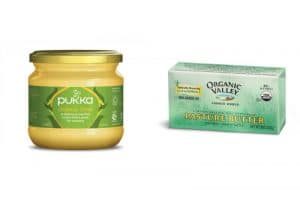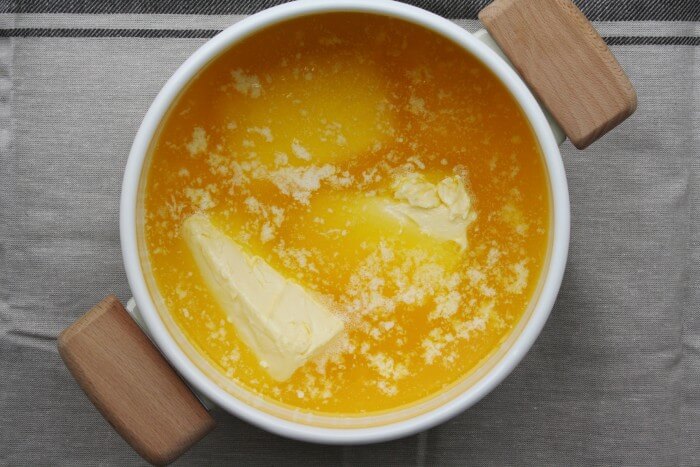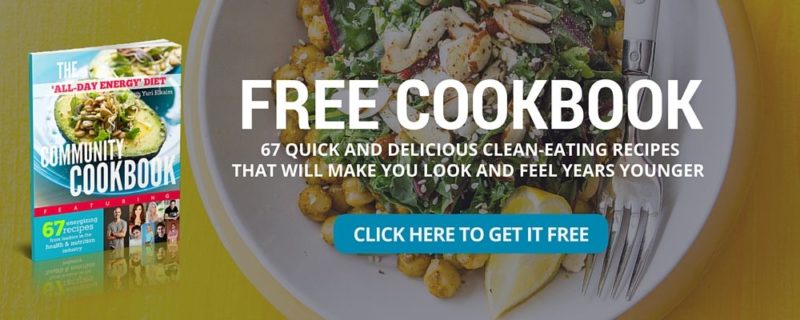Open up almost anyone’s refrigerator and there’s a pretty good chance you’ll find a tub of butter somewhere.
It’s a basic we use when baking, sautéing, and frying a lot of our food.
But how many of us have heard of ghee?
You might have seen it at your grocery store or heard of it mentioned at some point, but do you know what it is, or how to use it?
Ghee often draws a comparison to butter and is frequently used in place of butter to give a deeper, more intense flavor to dishes.
Interestingly enough, ghee is made from butter through a process similar to clarified butter.
Still, ghee and butter each have their own distinct flavor and contain a unique set of benefits. So which is the better option? Let’s explore.
What is Ghee Butter?
Ghee might have come into the spotlight only recently, but did you know that it has been a staple in southeast Asian cuisine for thousands of years?
Traditional Indian-inspired dishes like curries and lentil dishes rely on ghee to provide a flavorful kick. Ghee can also be used anywhere you would use butter, in the same amounts.
Ghee is similar to clarified butter, but varies in the way that it’s produced. Usually made from the milk of a cow or buffalo, ghee is made by melting butter and then skimming the fat from the top, separating the milk solids and water.
The final product is a yellow liquid that eventually turns into a creamy solid once cool. Because the milk fats are all removed, it allows the ghee to be stored for longer periods of time without going rancid.
When comparing ghee vs clarified butter, ghee has a very distinct nutty essence. This is because the butter is simmered along with the milk solids, giving ghee a richer, more unique flavor.
But which comes out on top between butter and ghee?
Butter vs Ghee
When talking about the benefits of ghee vs butter, ghee boasts some serious advantages. But is ghee healthier than butter?
Let’s take a look at some of the top benefits of ghee and see how they compare to butter.
1. Lactose and Casein
Good news if you’re sensitive to either lactose or casein: because of the way ghee is produced, it is free of both.
Lactose (a type of sugar found in milk) and casein (a kind of protein present in milk) are both found in most dairy products. The problem lies in the fact that these are both common allergens and a substantial chunk of people are sensitive to them.
An estimated 65 percent of the worldwide population loses its ability to digest lactose in adulthood, which can cause unpleasant and uncomfortable symptoms like bloating, indigestion, and flatulence.
That means that, for a significant portion of the population, ghee is an excellent option because it is lactose-free (1).
Butter, on the other hand, does contain small amounts of both casein and lactose. Although it’s unlikely to cause any major upset if you’re only mildly intolerant of either of these, it can cause issues for those who are highly sensitive.
If you’re following a milk-free diet, ghee is a great choice over butter. Though it’s not necessarily vegan because of the way it’s produced, it is free of all milk fats.
Winner: Ghee
2. Butyric Acid
When we eat dietary fiber, it feeds our healthy gut bacteria and effectively promotes optimal digestive health. The gut microbiota then produce a short-chain fatty acid known as butyric acid, which has been shown to have multiple beneficial health effects.
Butyric acid has been shown to support normal cell growth and differentiation and has even been linked to a decreased risk of colon cancer (2).
Also, butyric acid is known as an anti-inflammatory agent. Multiple studies have examined the effects of butyric acid on inflammatory status in patients with ulcerative colitis and found that increases in concentration were linked to improvement in symptoms.
Ghee and butter are both rich in butyric acid, making them excellent additions to an anti-inflammatory, health-supportive diet.
Winner: Tie
3. Conjugated Linoleic Acid
Besides being high in butyric acid, butter and ghee are packed with another type of fatty acid known as conjugated linoleic acid (CLA). This powerful form of fatty acid has been heavily researched for its many benefits, especially its potential effects on weight control.
Although results have been mixed, several studies have established a link between body composition and intake of CLA. One meta-analysis compared the results of 18 studies and found that CLA was associated with a modest loss of body fat (3).
CLA has also been associated with multiple heart-healthy benefits. In fact, one animal study found that intake of CLA-enhanced ghee dropped cholesterol and triglyceride levels while favorably upping high-density lipoprotein levels (4).
While some people opt to get their dose of CLA from a supplement, making smart selections with your diet can yield the same positive results.
Conjugated linoleic acid is found in meat and dairy products, including both butter and ghee. Always opt for grass-fed varieties, however, as the CLA content is significantly higher (5).
Winner: Tie
4. Fat-Soluble Vitamins
Need another reason to include ghee in your diet? Add its impressive profile of fat-soluble vitamins to the list.
This is also one of the benefits of butter, but ghee has even higher amounts of important fat-soluble vitamins A, D, E, and K.
Vitamin A is essential for maintaining healthy vision and also acts as a powerful antioxidant, crushing free radicals and preserving cell integrity.
Very few foods naturally contain vitamin D, and most of us rely on sun exposure to meet our requirements. This can be a big problem in the winter when our bodies aren’t able to produce as much vitamin D, so supplementing with foods rich in vitamin D can ensure we are maintaining strong bones.
Vitamin E acts as an antioxidant, protecting cells from damage and upholding our immune function.
Finally, vitamin K is an important factor in blood clotting and helping our blood to coagulate properly.
It’s always important to combine fat-soluble vitamins with a source of fat to ensure maximum absorption and utilization in the body. Getting these vitamins from ghee helps to guarantee that you’re getting the most from these vitamins.
Winner: Ghee
5. Smoke Point
Having a high smoke point tops the list of ghee’s benefits. Selecting a fat with a high smoke point is crucial when cooking, as heating oils above their smoke point causes them to break down and release free radicals, which can take a toll on your health over time.
The buildup of free radicals is associated with a multitude of health problems, especially cancer and heart disease. Using a fat with a high smoke point, like ghee, is one great way to prevent the formation of free radicals.
Additionally, most oils traditionally used for cooking – such as canola oil or soybean oil – are not ideal choices because they contain genetically modified ingredients.
Vegetable oils, known for their high smoke point, are also rich in inflammatory omega-6 fatty acids.
Butter has a smoke point of around 350 degrees F (177 C) while ghee’s smoke point is around 450 F (232 C). This makes ghee an optimal choice when it comes to cooking with high heat.
Winner: Ghee
How To Make Ghee From Butter
Now that we’ve established a few of the many benefits of ghee, are you ready to give it a try?
Making ghee from butter is actually a pretty simple process and can easily be done at home.
Image courtesy: Maunika Gowardhan – Get her recipe here.
Here’s how it’s done:
What You Need:
- 1 lb. grass-fed unsalted butter
- Deep skillet
- Mesh skimmer
- Cheesecloth
- Mesh strainer
- Glass jar
Directions:
Put butter into a deep skillet over medium-low heat and melt slowly. Stir occasionally and simmer between 20 to 30 minutes.
Once a white foam forms on the top, use a mesh skimmer to scrape from the top and discard. Repeat if more foam forms on the top.
Allow ghee to continue simmering until golden brown, but do not allow it to burn. Remove from heat and let it cool to room temperature.
Place a few layers of cheesecloth in a mesh strainer and pour the butter into a jar slowly.
Be sure to seal the jar properly and store in the refrigerator to achieve a spreadable texture. Ghee can last several weeks when stored at room temperature and is good for months when stored in the refrigerator.
Store-Bought Ghee Tips
If you do decide to go for store-bought ghee, be sure to avoid vegetable ghee.
This type of ghee typically contains hydrogenated vegetable oils (aka trans fats) to lower costs and can be harmful to our health.
How to Use Ghee
Ghee is easy to incorporate into your cooking at home and can give new life to even the most basic of dishes. Simply swap it out wherever you would normally use butter. This grain-free apple pie recipe from Deliciously Organic is just one delicious example.
Give it a try and see what you think! You’ll be reaping tons of health benefits and your tastebuds will definitely thank you.
Healthy-Up Your Dinners
Healthy homemade dinners don’t have to be a time-consuming drag to prepare.
In fact, our community has come up with dozens of amazing recipes that are gluten- and dairy-free, low in other allergens, and are quick to prepare.
You can get them free in the All Day Energy Diet Community Cookbook.
Click the banner below to get your copy!

